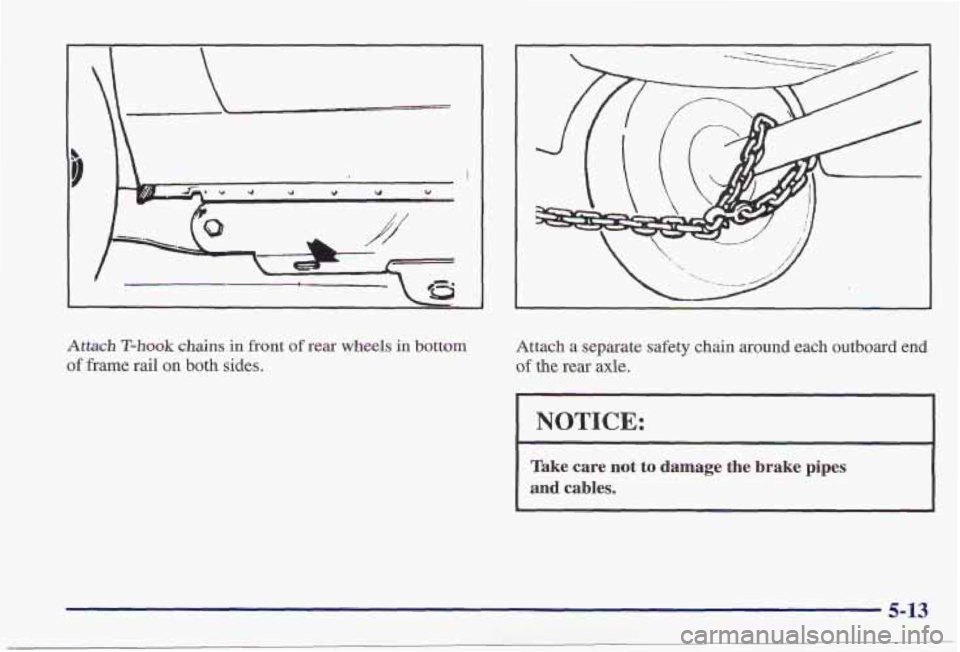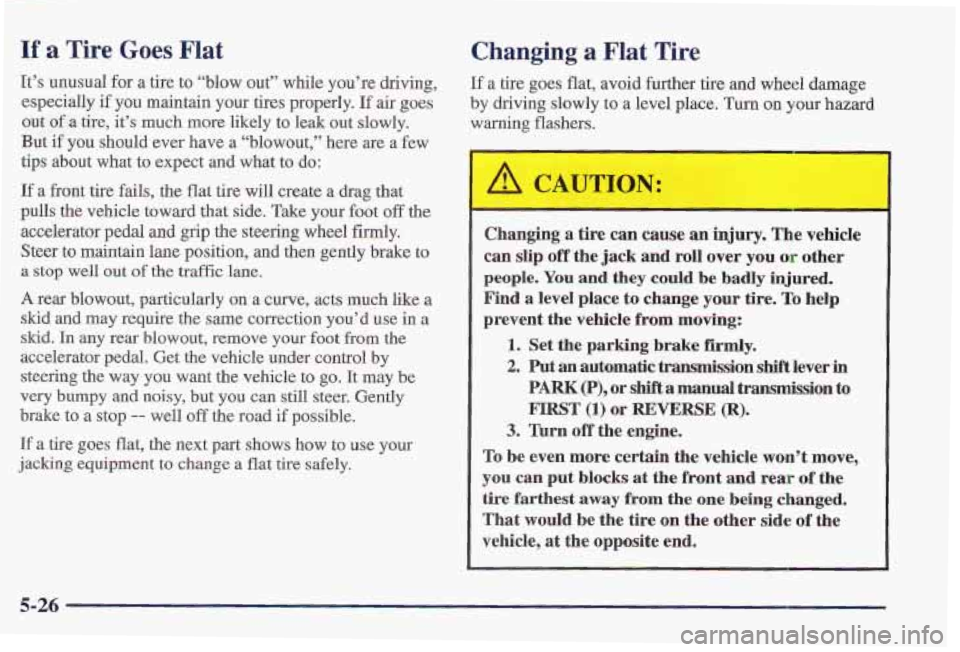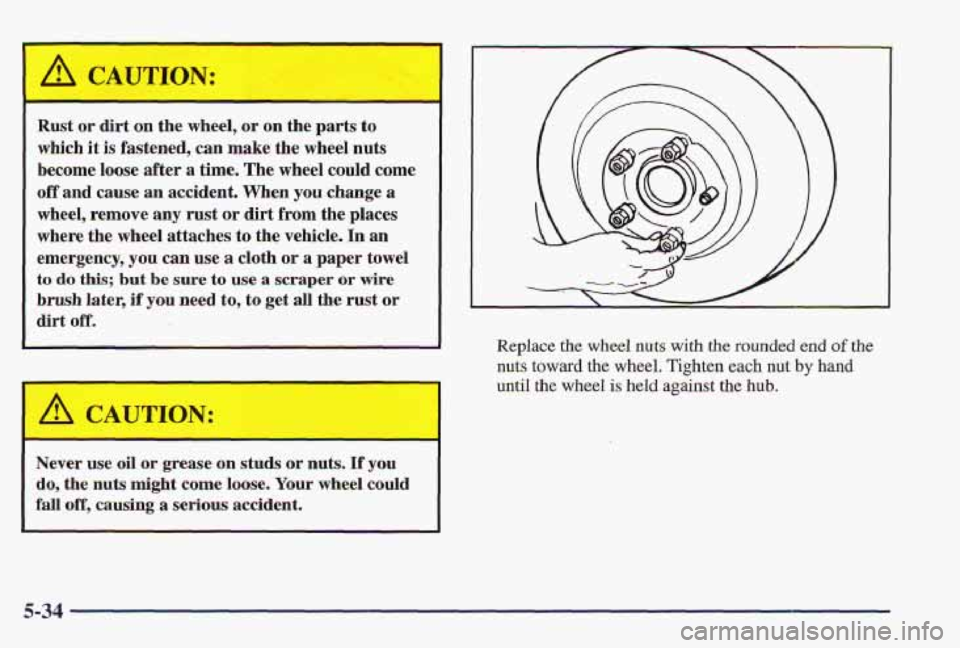wheel PONTIAC FIREBIRD 1997 Service Manual
[x] Cancel search | Manufacturer: PONTIAC, Model Year: 1997, Model line: FIREBIRD, Model: PONTIAC FIREBIRD 1997Pages: 410, PDF Size: 19.2 MB
Page 218 of 410

r
Attach T-hook chains in front of rear wheels in bottom
of frame rail on both sides.
Attach a separate safety chain around each outboard end
of the rear axle.
I NOTICE:
Take care not to damage the brake pipes
and cables.
5-13
Page 231 of 410

If a Tire Goes Flat
It’s unusual for a tire to ‘‘blow out’’ while you’re driving,
especially if you maintain your tires properly. If air goes
out of a tire, it’s much more likely to leak out slowly.
But
if you should ever have a “blowout,” here are a few
tips about what to expect and what to do:
If a front tire fails, the flat tire will create a drag that
pulls the vehicle toward that side. Take your foot off the
accelerator pedal and
grip the steering wheel firmly,
Steer to maintain lane position, and then gently brake to
a st,ot, well out of the traffic lane.
A rear blowout, particularly on a curve, acts much like a
skid and may require the same correction you’d use in a
skid. In any rear blowout, remove your foot from the
accelerator pedal. Get the vehicle under control
by
steering the way you want the vehicle to go, It may be
very bumpy and noisy, but you can still steer. Gently
brake
to a stop -- well off the road if possible,
If
a tire goes flat, the next part shows how to use your
jacking equipment to change a flat tire safely.
Changing a Flat Tire
If a tire goes flat, avoid further tire and wheel damage
by driving slowly t,o a level place.
Turn on your hazard
warning flashers.
Cham- ng a tire can cause an injury. The vehicle
can
slip off the jack and roll over you or other
people. You and they could be badly injured.
Find
a level place to change your tire. To help
prevent the vehicle from moving:
1. Set the parking brake firmly,
2. Put an automatic transmission shift lever in
PARK (P), or shift a manual transmission tu
FIRST (1) or REWRSE (R).
3. Turn off the engine.
To be even more certain the vehicle wan? move,
you can put blocks at the front and rear of the
tire farthest away from the one being changed.
That would
be the tire on the other side of the
vehicle, at the opposite ~ end,
5-26
Page 233 of 410

If you have speakers in the trim panel, you may have to
disconnect the wire from the speaker. The speaker wire
may be long enough to remove the trim panel without
disconnecting
the wire.
Remove the wing nut and adapter and
pull out the spare.
To remove the jack and wheel wrench, loosen and
remove the bolt and remove the plastic cover.
5-28
Page 234 of 410

The tools you’ll be using include the jack (A) and wheel
wrench
(B).
The jack has a bolt at the end. Attach the wheel wrench
to the jack
bolt.
Turn the wheel wrench to the right to raise the lift head
a little.
5-29
Page 235 of 410

If your wheel has a bolt-on center cap, loosen the plastic
caps using the wheel wrench. Each wheel has one locknut in place
of the standard
wheel nut.
A special wheel lock key (removal tool) and
instructions are
located in the center console. Attach the
wheel lock
key to the socket of the wheel wrench.
Remove the locking whe'el nut by turning
counterclockwise.
5-30
Page 236 of 410

Removing the Flat Tire and Installing the Spare Tire
1. Using the wheel wrench, loosen all the wheel nuts.
Don’t remove them yet. Position the
jack under the vehicle. There
is a notch
in the vehicle’s rocker flange
on the coupe model.
Raise the jack head until
it fits firmly into the notch
nearest the flat tire.
On convertible models, place
the jack in a
similar location.
5-31
Page 238 of 410

3. Remove any rust or dirt
from the wheel bolts,
mounting surfaces and spare wheel.
Raise the vehicle
by rotating the wheel wrench
clockwise. Raise the vehicle far enough
off the
ground
so there is enough room for the spare tire to
fit. Remove all the wheel nuts and take
off the
flat tire.
5-33
Page 239 of 410

~ Rust or dirt on the
wheel, or on the parts to
which it is fastened, can make the wheel nuts
become loose after a time.
The wheel could come
off and cause an accident. When you change a
wheel, remove any rust or
dirt from the places
where the wheel attaches to the vehicle.
In an
emergency, you can use a cloth or a paper towel
to do this; but be sure to use a scraper or wire
brush later, if you need to, to get all the rust or
dirt
off.
Never use oil or grease on studs or nuts. If you
do, the nuts might come loose. Your wheel could
fall off, causing a serious accident,
Replace the wheel nuts with the rounded end of the
nuts toward the wheel. Tighten each nut by hand
until the wheel is held against the hub.
5-34
Page 240 of 410

5. Tighten the wheel nuts firmly in a criss-cross
sequence as shown.
4. Lower the vehicle by rotating the wheel wrench
counterclockwise. Lower the jack completely.
5-35
Page 241 of 410

Incorrect wheel nuts or improperly tightened
wheel nuts can cause the wheel
to become loose
and even come
off. This could lead to an accident.
Be sure to use the correct wheel nuts.
If you have
to replace them, be sure to get new
GM original
equipment wheel nuts.
Stop somewhere as
soon as you can and have the
1 nuts tightened with a torque wrench to 100 lb-ft
(140 N.m).
--
NOTICE:
Improperly tightened wheel nuts can lead to
brake pulsation and rotor damage.
To avoid
expensive brake repairs, evenly tighten the
wheel
nuts in the proper sequence and to the proper
torque specification.
Don’t try to put a center cap on your compact spare
tire. It won’t fit. Store the center
cap in the rear area
until you have the flat tire repaired or replaced.
NOTICE:
Center caps won’t fit on your compact spare. If
you try to put a center cap on your compact
spare, you could damage the cover or @he spare.
Sto-5g a Flat or Spr-s Tirp --d To&
Storing a jack, a tire or other equipment in the
passenger compartment
of the vehicle could
cause injury.
In a sudden stop or collision, loose
1 equipment could strike someone. Store all these
~ in the proper place.
5-36